|
Books about the Great
Sphinx & Pyramids
“Pyramid Quest: Secrets of the Great Pyramid and the Dawn of Civilization”
by
Dr Robert M. Schoch
&
Robert Aquinas Mcnally
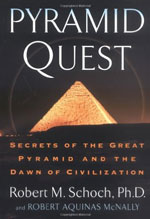
“How is it that the Great Pyramid exercises such a gripping hold on the human psyche adding cryptic grace and framing myriad claims of New Age “pyramid power”? In “Pyramid Quest”, Robert M. Schoch and Robert Aquinas McNally use the rigorous intellectual analysis of scientific inquiry to investigate what we know about the Great Pyramid and develop a stunning hypothesis: this ancient monument is the strongest proof yet, that civilisation began thousands of years earlier than is generally thought, extending far back into a little-known time.
In tracing that story, we come to understand not only the Great Pyramid but also our own origins as civilised beings.”
Get This Book From:
Amazon.com
Amazon.co.uk
“Voices of the Rocks:
A Scientist Looks at
Catastrophes and
Ancient Civilizations”
by
Dr Robert M. Schoch
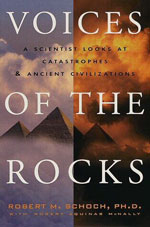
“The great 19th-century battle between catastrophists and uniformitarians seemed to end with the notion of global cataclysms being dismissed as a back door to the supernatural.
But the catastrophist theory has gradually become more and more plausible, so that now, less than a hundred years later, it is widely believed that mass extinctions are linked to meteor strikes.”
Get This Book From:
Amazon.com
Amazon.co.uk
“Voyages of the
Pyramid Builders”
by
Dr Robert M. Schoch
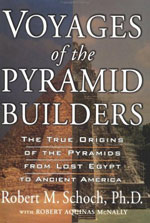
“Is it a mere coincidence that pyramids are found across our globe? Did cultures ranging across vast spaces in geography and time, such as the ancient Egyptians; early Buddhists; the Maya, Inca, Toltec, and Aztec civilizations of the Americas; the Celts of the British Isles; and even the Mississippi Indians of pre-Columbian Illinois, simply dream the same dreams and envision the same structures?
In this dramatic and meticulously reasoned book, Schoch, like anthropologist Thor Heyerdahl in his classic Kon-Tiki, argues that ancient cultures traveled great distances by sea.”
Get This Book From:
Amazon.com
Amazon.co.uk
“Giza: The Truth”
by
Ian Lawton
&
Chris Ogilvie-Herald
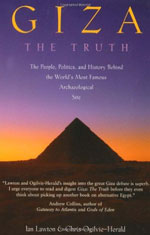
“GIZA: The Truth is one of those long awaited books that presents a more complete history of the Giza plateau than has been previously published by both the ‘alternative’ and ‘orthodox camps’. Both Ian and Chris should be applauded in their efforts to give the public a balanced view of the theories, discoveries, history and political shenanigans behind ‘the worlds most famous archaeological site’.
Get This Book From:
Amazon.com
Amazon.co.uk
|
|
The mystery of the Great Sphinx of Egypt has perplexed many of the world’s great thinkers, historians and archæologists. The generally accepted view of ‘Egyptologists’ is that the erosion evident on the structure has been caused solely by a combination of wind and desert sand. But Dr. Robert M. Schoch, a geology professor at Boston University, USA, believes he has found unmistakable evidence that at least some of the weathering and erosion was caused by rain-water many, many centuries, maybe many millennia, before the extreme arid conditions of the modern Sahara set in.
Consequently, he feels that the structure is likely to be several millennia older than many Egyptolgists have hitherto supposed. He gives his reasons for concluding this in great detail in his controversial book
“Voices of the Rocks”, and has become for many the definitive expert on the dating of the Great Sphinx on the Giza plateau.
The concept of an ‘Alternative Egyptology’ school is nothing new. It’s been around almost forever, but has lain hidden for the most part beneath the public image of the academic Egyptologists’ interpretation of Egyptian prehistory as presented in their standard chronology.
But bubbling beneath the surface there has always been a great deal of acrimonious debate amongst archæologists, and also between the archæological community generally and those of other disciplines within the historical sciences, regarding chronologies.
A respected professor of geology, Dr. Schoch brings to the ‘Ancient Egypt debate’ the careful methodology of a scientist in a discipline that has much of value to contribute to the debate surrounding the age of the Great Sphinx. This is carefully guided by a curiosity about ancient mysteries that brings a fresh and open mind to what is often seen as a dusty academic subject.
Like many other recent contributions to the ‘prehistory debate’, which reframes old questions, and thereby raise many more, he has broadened the scope of his research to include the dynamic recent history of the Solar System – itself under review as we enter the 21st century.
This new appreciation of ‘just how dynamic’ has been the recent history of the Solar System in which our planet Earth exists, is directly responsible for a new understanding of the periodic rise and collapse of civilisations over the past several millennia. The cyclical nature of encounters with comets, and the more regular encounters with the trails of cometary debris they leave behind as they pass through our Solar System, is increasingly being cited as the probable cause of the abrupt climate changes that led many ancient civilisations to collapse.
Some have ventured the opinion that it was just such a ‘cosmic catastrophe’ that led to the desertification of the Sahara, which was once as green and lush as other parts of Africa further south.
Described by some as ‘New Age prehistorians’, this alternative school of interpretation comprises many trains of thought, though the common thread between them remains almost exclusively the issue of astronomy. If the more adventurous astronomers and astro-physicists are correct, and a giant comet entered our Solar System sometime in the past 20,000 years, fragmenting into many pieces, with each creating their own particular debris stream, then it would seem very unusual if ancient peoples around the world would have been unaware of the spectacular celestial displays that encounters with these meteor streams would have generated.
And by the same token it would be very unusual if ancient peoples had not attempted, by some means or another, to predict the periodic return of these cometary encounters, given the very definite cyclical nature of our planet’s passage through these debris streams as their obital paths cross that of the Earth.
Evidence is mounting that the meteor showers of past times were much more spectacular than those we see today, and that they were closer to storm intensity, containing much larger pieces of cometary debris which bombarded the Earth regularly during the Bronze Age, and are now almost depleted.
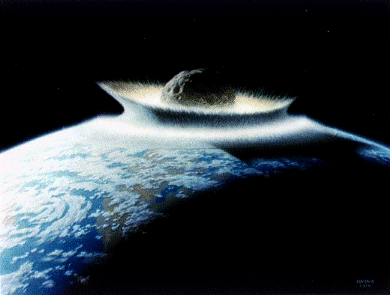
a painting by Donald E. Davis for NASA
It was these bombardments of our planet, combined with episodes of
dust-loading of the stratosphere that accompanied them, that are now regarded as having been the main cause ot the abrupt climate change that undermined the agricultural base of many ancient cultures. Undoubtedly, all eyes would have been firmly fixed on the ancient skies throughout these epochs.
Three of the leading researchers of the so-called school of ‘Alternative Egyptology’,
Graham Hancock,
Robert Bauval, and
John Anthony West, have awoken the curiosity of millions of people worldwide regarding the mysteries of past civilisations.
They have tried to marry the alternative archaeology of the late 20th century with the new understanding of astronomy that is emerging alongside ‘paradigm shifts’ in the historical sciences generally. They have also claimed that the astronomical considerations that are now generally accepted to have been built into the design and siting of many ancient megalithic monuments, is in itself irrefutable ‘proof’ that those monuments were built by an advanced prehistoric civilisation which prehistorians and archæologists have rejected or ignored.
But within the last year or so, former devotees of the ‘lost civilisation’ theories of Hancock and Bauval have begun to take a more critical look at their claims. Two of these are Ian Lawton and Chris Oglivie-Herald, and their book
“Giza: The Truth”, was featured in the January 27th 2000 edition of the “Daily Express” newspaper, by David Rohl. The article focussed partly on Bauval’s recent book,
“Secret Chamber”, and the purported existence of a
secret chamber at the end of the southern ventiliation shaft of the Queen’s Chamber, in the heart of the Great Pyramid of Giza.
It was discovered a few years ago by a German engineer, Rudolf Gantenbrink, who had sent a miniture robot up inside the 8 x 8 inch vent, discovering that after 200ft the shaft came to an abrupt end at what appeared to be a portcullis door with copper handles. On January 27th 2000, another controversial ‘alternative historian’, David Rohl, in an article in the UK “Daily Express”, said of this:
“However, the alternative movement, led by Bauval, is predicting that beyond the door lies a repository of knowledge which will prove the existence of a lost civilisation dating to around 12,000 years ago – the sacred scrolls or tablets of Atlantis.
The stakes are high. The hero worship surrounding Hancock and Bauval would rapidly wane if no such evidence came to light. So far, their theories have, in part, been sustained by their ability to claim that the proof is just around the corner but that they are being thwarted by the powers-that-be.
If this situation is now changing, it seems that the crunch is coming for Alternative Egyptology. Its leading lights will very soon be seen as either revolutionary thinkers or a bunch of ‘pyramidiots’.”
[1]
Described by Rohl as ” … an excellent example of this more sober approach … “, and also as ” … an in-depth criticism of Hancock and Bauval’s theories … “[2], Lawton and Ogilvie-Herald’s book,
“Giza: The Truth”, also takes a critical look at the debate surrounding the age of the Great Sphinx. Although the author of The Express article, David Rohl, mentions their criticism of the work of
Dr. Robert M. Schoch in just one passing sentence, the context in which he uses it is unfortunately reminiscent of the controversial BBC “Horizon” TV programme:
“What is also debatable is the age of the Sphinx. Dr Robert Schoch, of Boston University, has stated that erosion in the cutting walls where the Sphinx is located must have been made by water. As a result, he places the carving of the Sphinx around 6,000 BC, when the Neolithic Wet Phase was at its peak.
Although they embrace this new discovery, Hancock and Bauval, along with their colleague John Anthony West, would still prefer to retain their theory that the monuments date to 10,500 BC because it is constistent with their other arguments.
However, two other factors might give pause for thought. First, as Lawton and Ogilvie-Herald point out, the salts in the limestone of the Giza plateau cause rapid erosion. Second, the Neolithic Wet Phase continued until the Fourth Dynasty when the pyramids were built.”
[3]
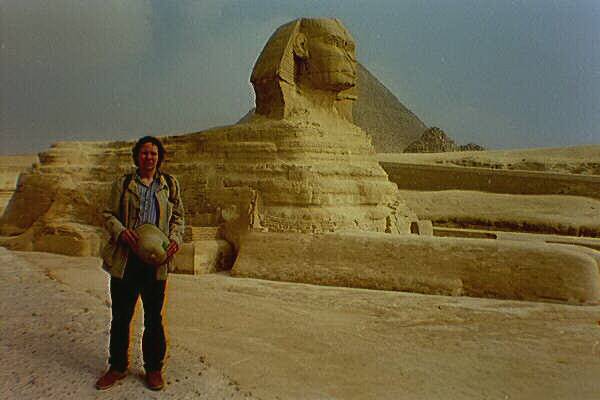
Dr Robert M. Schoch’s response to criticisms by Ian Lawton & Chris Ogilvie-Herald in their book
“Giza: The Truth” begins on:
Page Two
|
|
if you would like to help and support
The Morien Institute
Research Projects
please send us a book

from our Wish List
“The Pyramids and Temples of Gizeh”
by
W. M. Flinders Petrie
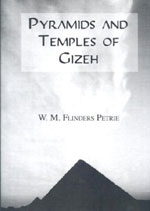
“Based on the author’s work in Egypt in the 1880s, this unusual volume addresses one of history’s greatest puzzles — how were the pyramids of Gizeh built? Before Petrie undertook this study, the Great Pyramid was a byword for paradox – something that was generally familiar, yet not accurately known. No measurements or detailed examination had been performed. Petrie set out to apply mathematical methods to the study of the pyramids and surrounding temples, with the objective of understanding the methods and abilities of the ancient workers.
The result, presented in this volume, is a complete set of measurements of the pyramids, both inside and outside. These provide the foundation for the rest of the book, which deals with the architectural ideas of the pyramid builders, the mechanical methods they used, and a comparison of previous theories with the facts that Petrie had newly established.”
Get This Book From:
Amazon.com
Amazon.co.uk
“Quest for the
Lost Civilisation:
Boxed Set”
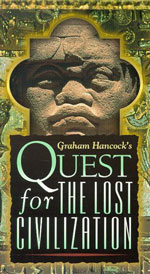
with Graham Hancock
VHS NTSC version
(USA and Canada)
VHS UK PAL version
(UK and Europe)
“The Message of the Sphinx: A Quest for the Hidden Legacy of Mankind”
by
Graham Hancock
&
Robert Bauval
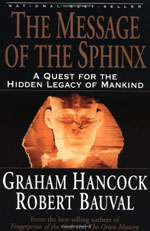
“The authors have done a great work of research here. Based on astronomy and archeology, with some hints at astrology and metaphysic knowledge, Mr Hancock and Mr Bauval take us through a journey in time, trying to get back to the origins of the always mystical and eningmatic Pyramids and Sphinx.
Through this book you will be able to learn about the constant attempts they and many other researchers have made to go deeper in the study of the Sphinx, in concrete, to try and find the secret chambers that lie beneath the monument, and how all of those attemps have been met with a burocratical “no” from the different administrators of the site.”
Get This Book From:
Amazon.com
Amazon.co.uk
Ancient Egyptian
Mysteries Bookshoppe
“The Mystery of the Sphinx”
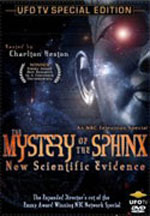
Get This DVD From:
Amazon.com
Amazon.co.uk
|